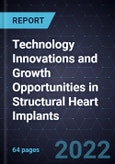Biomaterials and Design Advances Improve the Efficacy and Safety of Heart Valves and Occluders
Structural heart diseases (SHD) encompass cardiac conditions that cause abnormal blood flow inside the heart's chambers, which can be wrong blood flow direction or blood stagnation. Structural abnormalities in the heart lead to impaired functioning rather than the heart's blood vessels. The cardiovascular implants industry has developed prosthetic valves and occluders to repair structural cardiac defects. This research study analyzes technological innovations in transcatheter mitral valve replacement/repair (TMVr/TMVR) implants and atrial septal defect (ASD) occluders. These implants are evolving to become more biomimetic and intelligent with artificial intelligence (AI)-enabled deployers.
The report also covers the following:
- Industry trends
- Active R&D areas
- Emerging technologies
- Notable stakeholders
- Growth opportunities
Table of Contents
1. Strategic Imperatives
- Why Is It Increasingly Difficult to Grow? The Strategic Imperative 8™: Factors Creating Pressure on Growth
- The Strategic Imperative 8™
- The Impact of the Top 3 Strategic Imperatives on the Structural Heart Implants Industry
- Growth Opportunities Fuel the Growth Pipeline Engine™
- Research Methodology
2. Growth Opportunity Analysis
- SHD Overview
- Most Prevalent
- Most Well-established Interventional Technique for Valvular Heart Disease: Percutaneous Mitral Valvuloplasty (PTMV)
- Structural Heart Implants Segmentation
- Interventional Treatment - Mainly for Patients at Surgical Risk
- Market Analysis of Technologies
- Growth Drivers
- Growth Restraints
- Scope of Analysis
3. Transcatheter Mitral Valves Repair/Replacement Implants - Technology Analysis
- Preference to Mitral Valve Repair over Mitral Valve Replacement
- Mitral Valve Material Analysis
- Self-expanding Frame of the Valves Generally Comprises Nitinol
- Most-adopted Design Intervention - Trileaflet Valve Comprising Pericardium in a Self-expanding Nitinol Frame
- United States Has the Most Innovations in TMVr/TMVR
4. Transcatheter Atrial Septal Defect (Tc-ASD) Closure Devices - Technology Analysis
- Tc-ASD can Treat ASD of Septum Secundum
- ASD Material Analysis - Nitinol Wireframes Causing Erosion in Implanted Tc-ASD Devices
- Flexible Petal Design Ensures Less Friction Minimizing the Erosion
- Gore Medical Tc-ASDs are FDA Approved and are the Most Successful
- Tc-ASDs Geographical Analysis - United States Has the Most Innovations Dealing with Tc-ASDs
5. Industry Assessment
- AI-enabled Prosthetic Mitral Valves as the Future of TMVR/TMVr
- 3D-bio-printed, Bio-inspired ASD Occluder is the Future
- Structural Heart Implants for MIS
- Need for Balancing Innovation and Regulation
- Patent Database Analysis for TMVR/TMVr Industry
- Patent Database Analysis for ASD Closure Devices
- Emerging technology Analysis for Mitral Implants and ASD Occluders
- Application of AI in Cardiovascular Implants in the Growth Phase
6. Growth Opportunity Universe
- Growth Opportunity 1: Bio-inspired or Biomimetic Structural Heart Implants will Lead to Less Device Failure
- Growth Opportunity 2: Microelectronics and AI-enabled Smart Implants for Capturing Real-time Heart Parameters
- Growth Opportunity 3: Collaborative/In-house Development of Visualization Techniques with Cardiac Implants
7. Appendix
- The Latest Patents Include AI and ML-enabled Intelligent Structural Heart Implants
- Technology Readiness Levels (TRL): Explanation
8. Next Steps
- Your Next Steps
- Why Now?
Companies Mentioned (Partial List)
A selection of companies mentioned in this report includes, but is not limited to:
- FDA
- Gore Medical








